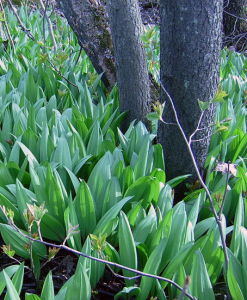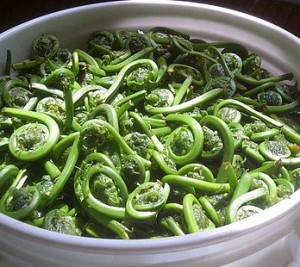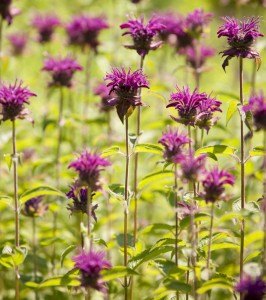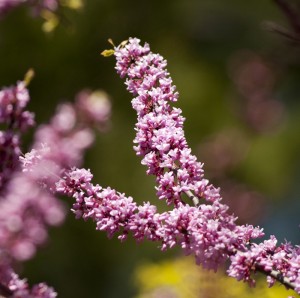Native Nibbles
Posted in Gardening Tips on April 23 2014, by Sonia Uyterhoeven
Sonia Uyterhoeven is the NYBG’s Gardener for Public Education.

Whether or not you realize it, you have been eating native plants for most of your life. Most of us have enjoyed blueberry muffins or pancakes from a very young age, partaking in one of the northeast’s most commercially successful homegrown natives. But that’s only the most well-known of our local edibles.
If you’re the adventurous type, you may have tried some of the more unusual natives to be found at local farmers markets or high-end grocery stores. The more advanced among you may even have foraged some of your own, though this activity comes with an all-important disclaimer: only do so if you are an expert in plant identification or happen to be accompanied by one. As you will soon see, many of the tastiest native plants have relatives or lookalikes that can be highly poisonous. Having proper identification of these plants in hand will not only help you avoid danger, but keep you from damaging wild populations of protected or threatened plant populations. Further, you should never harvest wild plants unless it’s on your own property or you have explicit permission.
One native that’s seeing an increase in popularity these days is the wild leek, or ramp (Allium tricoccum). Ramps pop up in the spring, first with foliage that withers by late spring, then with a cluster of white flowers (an umbel) that sets seed by summer. These alliums thrive in the partial shade offered by woodland environments. Both the foliage and bulb can be eaten, offering an onion-like taste reminiscent of a seriously strong leek. You can even eat them raw. If you have a flare for the international, you can whip your ramps up in a frittata or risotto, bake them into biscuits, or add them to any spring salad. I have even had ramp pizza in a trendy New York restaurant, and can tell you without a doubt that it was delicious.
For the health conscious among us, anything in the allium family (onions, garlic, leeks, and ramps) is rich in vitamin B and C, as well as important minerals. Members of the onion family are known to help remove toxic metals such as lead and mercury from your body, and can help to improve circulation, relieve headaches, and provide an antibiotic boost.
Again, if you are foraging, proper identification is important. Ramps are edible, as are the native wild garlic (Allium canadense) and the nodding wild onion (Allium cernuum). There are other lookalike species, however, that are poisonous—such as star-of-Bethlehem (Ornithogalum umbellatum) and lily of the valley (Convallaria majalis). In the end, it’s best to stick to plants supplied by your local farmers market.

Ostrich fern (Matteuccia struthiopteris) is another tasty native treat. You will know it better by its common culinary name: the fiddlehead. The ferns are only edible in the spring, when they are young, as they become poisonous once they unfurl.
Ostrich fern fiddleheads are tasty and will likely remind you of asparagus. Many other similar types of ferns can be inedible, however. As fiddleheads become more popular among chefs and home cooks, you can expect to see them cropping up more often among farmers markets here and elsewhere. With these delicious green curls in your kitchen, you can dine on fiddlehead pizza, add them to your pasta dishes as a broccoli substitute, or simple saute them with garlic and red pepper flakes.
For the gardeners out there, know that I have grown ostrich fern before and find it extraordinarily successful in a shady woodland setting. In fact, I sometimes find it too successful, overpowering more timid natives and running amok in contained garden areas. Instead, think about growing your own tea, planting bee-balm or Oswego-tea (Monarda didyma). Its scarlet flowers are a hummingbird magnet and the aromatic leaves make a wonderful tea or seasoning. Since it is in the mint family, it tends to be a little rambunctious by nature, and needs moist to average soil and full sun to look its best.

Oswego tea is named for a New York tribe that taught the first settlers how to make it. After the Boston Tea Party, when much of the city’s English tea was floating in the harbor, locals drank Oswego tea as a substitute. It has a lemony, minty flavor to it. You can make a cup of your own by adding 2 teaspoons of fresh or dried flowers and leaves to 10 oz. of boiling water. Steep for 3-5 minutes and enjoy.
If you are in the mood for something a bit more refreshing in the coming summer months, you can always go for sumac lemonade instead. Some of the edible sumacs that you will find are winged sumac (Rhus copallina), staghorn sumac (Rhus typhina), and smooth sumac (Rhus glabra).
As there is also a notoriously poisonous sumac (Rhus vernix) which makes poison ivy (Toxicodendron radicans) look friendly by comparison, you should once again avoid trying to forage these for yourself.
The berries from the edible species—tart, tasty, and full of vitamin C—can be made into a flavorful lemonade in late summer and early autumn. To make the tea, just cover the berries with cold water and let it infuse for several hours or overnight. Strain with a cheese cloth and sweeten with sugar or your favorite honey. Straining is important to get rid of the hairs from the fruit.
Hawthorns (Crataegus) not only provide birds with fruit and protected nesting sites, but their fruits are high in pectin, making a great sauce or thickener for other late summer fruit compotes. The fresh fruit taste like mealy apples, though, so make sure you cook them thoroughly.

Hickories are best known for their famous southern cousin, the pecan (Carya illinoensis). Its lesser-known northern brethren, the shagbark hickory (Carya ovata) produces a tasty nut. Beware the pignut hickory (Carya cordiformis) however—its bitter nuts are cherished by pigs but not you or me.
Finally, reach up in the spring and pluck some of the flowers off of your redbud tree (Cercis canadensis); add it to your salads for a decorative touch and enjoy its delicious, pea-like flavor. For the careful yet curious, there are many interesting offers from nature’s bounty.
Allium tricoccum and Matteuccia struthiopteris images courtesy of Wikimedia Commons.

